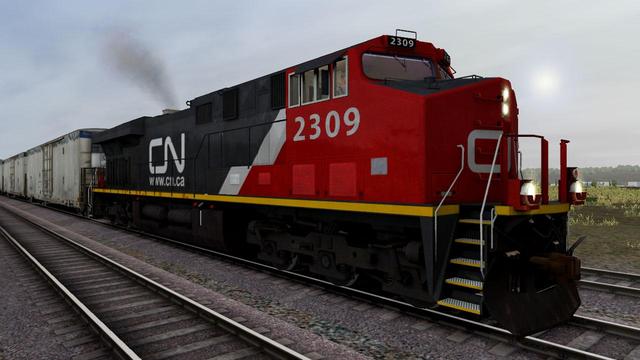This post has not been edited by the GamesBeat staff. Opinions by GamesBeat community writers do not necessarily reflect those of the staff.

It’s late evening at Castle Rock. Larkspur Wood Specialties, about a half-hour’s drive away, needs a shipment of goods. The lines ahead are fairly quiet and everything’s on schedule. I move the throttle and reverser levers in my SD-40-2 Wide Nose, ease up the brakes, and slowly make my way out of the cargo yard and down the track as the sun begins to dip below the horizon.
In reality, I’m toggling through the camera views in RailWorks 2, a British-made rail simulator game. It’s a unique gaming experience, allowing players to drive freight and passenger trains in a variety of locations. It deals with starkly different subject matter than most video game titles, yet has the complexity and challenges that any gamer can appreciate.
While my locomotive is supposedly part of the Castle Rock Railroad line, the black, red, and white livery gives it away in an instant: It’s a Canadian National Rail train. Is it possible that a sim developed in the United Kingdom provides the best facsimile of that Canadian tradition — running the railway from sea to sea?
RailWorks 2 is available on Steam; sales figures indicate that most Steam users are traditional gamers, favoring titles like StarCraft or Call of Duty: Black Ops. It’s a curiosity, then, that every few months a downloadable pack (DLC) for RailWorks 2 appears on Steam's New Releases tab.
Most big-budget video games issue DLC intermittently within their first year of release, in the hopes of rekindling interest and generating more income for the developers post-launch. RailWorks 2, however, has kept the DLC stream going for well over three years — that’s 82 packs in all (totalling more than $1,300).

Produced by London-based studio RailSimulator.com, RailWorks was released in 2009, and a massive upgrade re-christened it RailWorks 2 in September 2010. RailSimulator.com CEO Paul Jackson helped establish the UK branch of Electronic Arts over 20 years ago and was instrumental in building its empire, including co-founding the FIFA soccer franchise and serving as brand builder for The Sims.
Jackson has no illusions about his uncommon strategy for RailWorks 2.
“I think DLC on most games have historically been something you had to have [in order] to have the full experience. That is not true with what we do,” he says. According to Jackson, users are encouraged to buy the expansion packs containing the locomotives that they are most interested in. Usually, the interest is locally driven. Train fans on the UK’s West Coast Main Line, for example, are more likely to buy the package that re-creates it; a Canadian with a keen sense of nation-building history can pick the packs containing CN-commissioned trains.
Expansion packs with North American trains and liveries have been less frequent than European ones over RailWorks’s history, since Jackson’s team usually has to rely on roundabout ways of gathering info to accurately re-create the trains. In addition to using reference material provided by CN Rail, Jackson’s team used photographs taken by friends in Canada. The livery for the SD-40-2, for example, required roughly 200 photos.
As I cruise the Castle Rock in the CN-approved livery, though, one thing is missing from the experience: an actual Canadian rail line. Castle Rock is fictional, adapted from a Colorado line. Jackson says that’s due to the extensive amount of time and work needed to complete any real-world railroads.
“The West Coast Main Line, which was the last big line we released, took about 18 months to create,” he says. That hasn’t slowed down the team’s ambition, however, because the first Canadian line on their target list is the Rogers Pass, a high mountain pass that runs through the Selkirk Mountains in British Columbia.
“I was looking at Canadian National routes the other day, and I was looking at the Rogers Pass route, and I’d love to drive that. But the mountainous nature of it means that we’d need a draw distance that goes much further out than what we’ve got.”
Just allowing the camera to navigate around the mountainous scenery will be a key feature in an upcoming update, the largest planned release to the RailWorks platform yet. While Rogers Pass isn’t confirmed as a definite future update, the Portland Yard line in Maine and the Northeast Corridor — which goes from New York to Philadelphia — are upcoming North American releases.
It’s dark outside, and I’ve just parked my cargo into Larkspur Wood Specialties, which, to my eye, is basically a large warehouse. The drive was peaceful; partially thanks to the game’s fantastic sound design. The chug-chug of this diesel-powered monster duels with the clickety-clack of the rails and the wind that whips past the engineer’s window.
I ease the brakes gingerly; the last time I tried this I bumped into the guard fence at the end, derailing a car and failing the mission. The engine’s hissing peters out, and I’m done for the night.
Originally posted on CBCNews.ca
